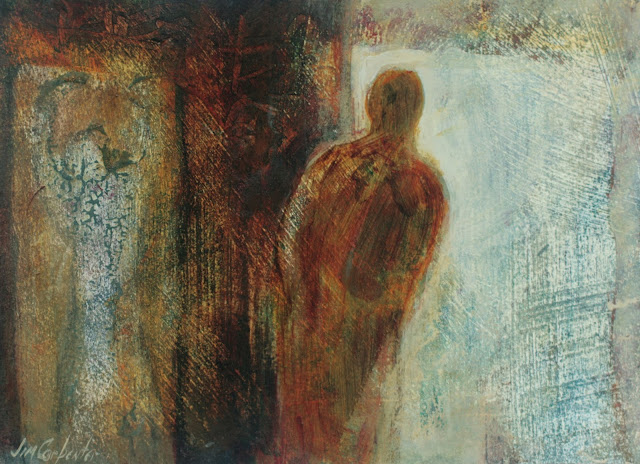"Shared Scene" by Jim Carpenter, Acrylic on Paper 7 1/4" x 11"
Day 30 - Painting #23 - The End of the Challenge: A New Beginning
Well, here is my last painting for the challenge designed by Leslie Saeta. When I started this 27 days ago I had no idea whether or not I'd be able to do it. I guess that is what a challenge is all about. You take a risk to meet the challenge. Artists need to be willing to take risks. Isn't there the risk of failure every time we pick up a brush or put our work on display?
I titled this painting "Shared Scene" because I noticed that the figures are in position for a shared scene on the stage. That triangle can shift the focus from one character to another with the slightest of movements. Right now it looks to me like the figure down left (viewer right) has the focus. The figure in the back is looking toward him. Just imagine any one of these figures turning their gaze, shifting the focus from the figure down left to the figure down right, or to put even more emphasis on the figure in the center imagine both figures turned toward him.
What is the point? I just want to suggest that the story being told in this painting is ongoing. That the three figures each have a certain amount of power to take focus and to raise questions about who they are and what they are considering regarding themselves and one another. They are separate but they are in this scene together, much like the 400 artists in Leslie's challenge. It is through opportunities like this that we get to breach the solitude of the studio and share the scene with our colleagues.
I have to say too that this painting, and the challenge itself, makes me think about not abandoning our muses, or, perhaps more to the point, about not fearing that our muses will abandon us. They are present - maybe not always easily detected - but they are present. We may need to dig deep to find them hidden away in some ancient cavern just waiting for us to call on them for inspiration. I am reminded of that when I look at my 23 paintings from this challenge.
I will continue to paint daily and to blog - not daily - but to blog often.
Congratulations to all of my art buddies in the challenge! Phew! We did it.
What is the point? I just want to suggest that the story being told in this painting is ongoing. That the three figures each have a certain amount of power to take focus and to raise questions about who they are and what they are considering regarding themselves and one another. They are separate but they are in this scene together, much like the 400 artists in Leslie's challenge. It is through opportunities like this that we get to breach the solitude of the studio and share the scene with our colleagues.
I have to say too that this painting, and the challenge itself, makes me think about not abandoning our muses, or, perhaps more to the point, about not fearing that our muses will abandon us. They are present - maybe not always easily detected - but they are present. We may need to dig deep to find them hidden away in some ancient cavern just waiting for us to call on them for inspiration. I am reminded of that when I look at my 23 paintings from this challenge.
I will continue to paint daily and to blog - not daily - but to blog often.
Congratulations to all of my art buddies in the challenge! Phew! We did it.




























